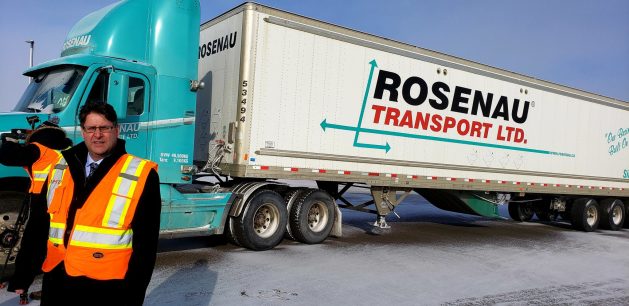Three new rest stops to open in Alberta
EDMONTON, Alta. – The Alberta Motor Transport Association’s (AMTA) advocacy efforts continue to pay off, with the government’s announcement of three new rest stops to be constructed in the province.
Alberta’s minister of transportation, Brian Mason, passed along the message during the association’s grand opening of its new state-of-the-art facility at the Edmonton International Airport March 6.
Two of the rest stops will be built along the Yellowhead Highway west of Hwy 43, both for eastbound and westbound traffic. The other will be along Hwy 2 at Wolf Creek, just north of Lacombe. The province is also supporting a private-sector rest stop near Bowden on Hwy 2.
Mason said the rest stops will be fully equipped, with washroom facilities, food, and an ample number of stalls for truck parking.
“These rest stops will offer plenty of opportunity for commercial expansion, including gas stations, restaurants, and facilities,” said Mason. “They will be safe places for truckers to pull off the highway and get some rest.”
Construction of the rest stops is expected to create 89 jobs, with building costs around $20 million.
“Safe highways are the number one priority for our government,” said Mason. “Rest stops allow our commercial carriers to rest so they are not fatigued behind the wheel. They’re also a good place for all of us to pull over and stretch our legs before getting back on the road.”
AMTA president Chris Nash said the announcement of three new rest areas was “a good step, but there are still more needed.”
Mason commended the AMTA for its efforts to push for more rest stops in the province, which is a nationwide issue, particularly with the ELD mandate looming.
He also said the association played a major role advocating for a mandatory entry-level driver training program, which took effect March 1, super singles, and other safety requirements for the industry.
“The partnership that we have developed has been very beneficial to the safety of our roads and to the economy of our province,” said Mason of the AMTA. “The AMTA has taken a lead role in safety initiatives all across the province.”
Building tour
In addition to the minister’s announcement, the AMTA invited media to tour its new Edmonton facility.
Equipped with a five-acre training track, two simulators, classroom space, a truck bay, and 6,000 sq/ft of space available for lease, the building is a major step up from its former location.
The building was constructed to LEED Silver standards, meaning it utilizes environmentally-friendly components like solar reflectance, electric vehicle charging stations, and a green roof, saving energy, water, and resources.
Nash said the training track can be used for a multitude of reasons by a variety of stakeholders, including AMTA-led training, carrier training, a combination of both, or training that was developed on-site and used at another location.
“It’s anything and everything,” said Nash. “One of our goals is that we want training to be consistent. That’s probably the biggest message we want to put out.”

Nash said many carriers tailor their training to suit their individual needs, and if a driver leaves one company for another, drivers can be put back into the training cycle because of a lack of consistent training methods.
“The inconsistency is out there and it will only be beat by training that we can bring everyone together and agree on, and this is a great nucleus for that,” said Nash.
Nash said the AMTA is eyeing future expansion of its training track, and funding efforts are in place to make that a reality.
With the space they have now, training is restricted to slow maneuvers, whereas if they are able to expand the track, training can include such things as emergency vehicle and smart city area testing.
The AMTA’s new facility is also the third component of the Alberta Aerospace and Technology Centre, which is based on the driving and flying simulators located on the site.
“You’ve got air, ground, and they now consider CP Rail to be close enough that we have all modes of transportation built out of this,” said Nash, “so it’s exciting to see all modes here, and a functional nucleus to become a resource to be able to try new things.”
Nash said testing done at their new facility provides a safe location to try out new technologies, such as platooning, automation, and driver assist, where there is no impact on the public.
He also said it’s important to have drivers understand these new technologies.
“Drivers who have been driving an older truck that doesn’t have it, it’s a transition,” he said. “Being able to bring that to the forefront and educate in a controlled environment or to build training for people to be safer and competent on the road, that’s was this facility is all about.”
Have your say
This is a moderated forum. Comments will no longer be published unless they are accompanied by a first and last name and a verifiable email address. (Today's Trucking will not publish or share the email address.) Profane language and content deemed to be libelous, racist, or threatening in nature will not be published under any circumstances.